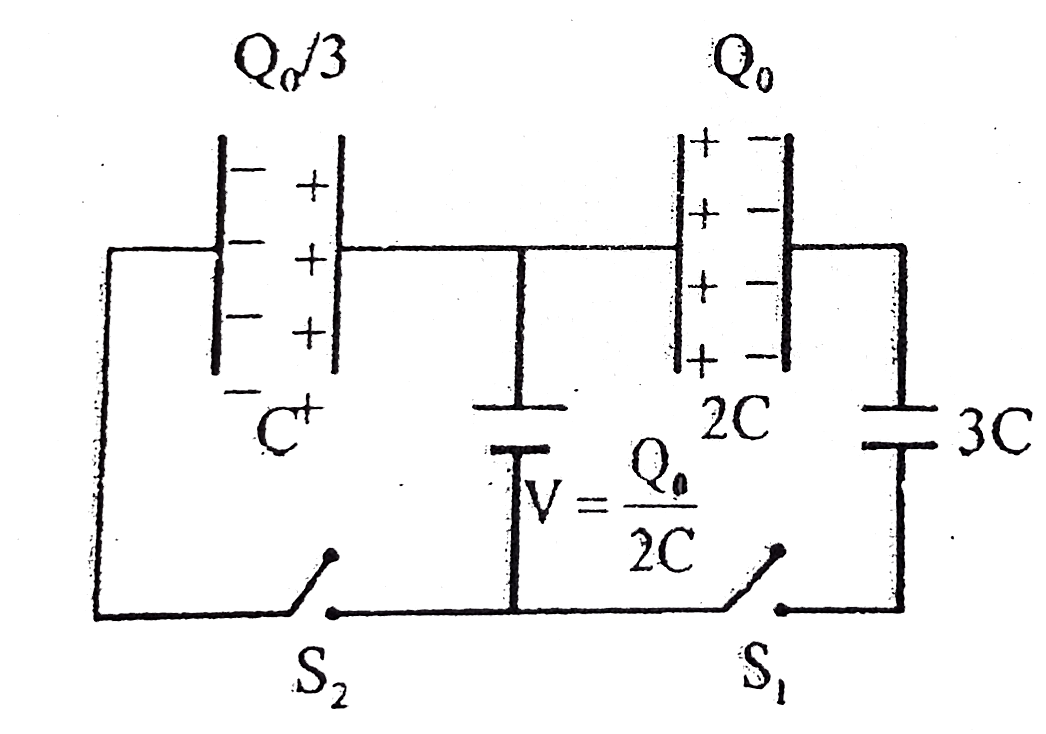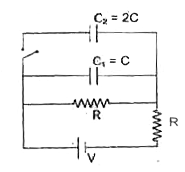In the given circuit, the initial charges on the capacitors are shown in the figure. The charge flown through the switches S1andS2 respectively after closing the switches are

A
zero,Q06
B
Q05,Q02
C
zero,Q02
D
35Q0,Q06
Video Solution
Text Solution
The correct Answer is:A
Let q(1) charge flows through s1 and q2 through s2. For capacitor of capacitance 2C,
Qo+q1=2CV=Q0 or q1=0
For capacitor of capacitance C.
Q03+q2=CV=Q02 or q2=Q06
|
Topper's Solved these Questions
- MISCELLANEOUS VOLUME 3BOOK - CENGAGE PHYSICSCHAPTER - MISCELLANEOUS VOLUME 3EXERCISE - Multiple Correct Answer type
109 Videos
- MISCELLANEOUS VOLUME 3BOOK - CENGAGE PHYSICSCHAPTER - MISCELLANEOUS VOLUME 3EXERCISE - Assertion and Reason Type
8 Videos
- MECHANICAL PROPERTIES OF SOLIDSBOOK - CENGAGE PHYSICSCHAPTER - MECHANICAL PROPERTIES OF SOLIDSEXERCISE - Question Bank
4 Videos
- MISCELLANEOUS VOLUME 5BOOK - CENGAGE PHYSICSCHAPTER - MISCELLANEOUS VOLUME 5EXERCISE - Integer
12 Videos
Similar Questions
Knowledge Check
Find the charge flown when the switch S is closed.
 AzeroBε0AdVC32ε0AdVDε0A2dV
AzeroBε0AdVC32ε0AdVDε0A2dVThe circuit was in the shown state from a long time. Now the switch S is closed. The charged that flows through the switch is
 A4003μCB100μCC50μCD1003μC
A4003μCB100μCC50μCD1003μCIn given circuit, switch S is closed at t=0 . The charge on the capacitor ar steady state will be
 ACεR1r+R1BCεR2r+R2CCεR2r+R1DCεR1r+R2
ACεR1r+R1BCεR2r+R2CCεR2r+R1DCεR1r+R2
Find the charge flown through the switch from A to B when it is closed.

View SolutionIn the given figure switch is open initially and capacitor C2 is unchanged

Charge on C2 just after closing the switch is
View SolutionIn the given LC circuit,if initially capacitor C has charge Q on it and 2C has charge 2Q. The polar ar as shown in figure. Then after closing switch S and t=0

View Solution
In the circuit shown, all the capacitors are initially uncharged. The current through the battery just after closing the switch 'S' is
View SolutionIn the given LC circuit if initially capacitor C has change Q on it and 2C has charge 2Q. The polarities are as shown in the figure. Then after closing the switch s at t=0

View Solution


